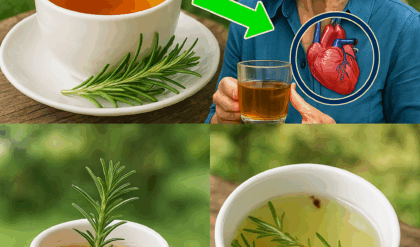✨ What if one of the most powerful superfoods didn’t come in a bottle or a fancy health aisle package—but grew freely in your garden, often mistaken for a weed? Meet purslane, scientifically known as Portulaca oleracea. This succulent plant, with its crisp texture and lemony tang, has been used for centuries in traditional healing practices and is now gaining recognition for its outstanding nutritional value.
Loaded with omega-3 fatty acids, antioxidants, and essential vitamins and minerals, purslane is one of the most nutrient-dense greens you can eat. Whether you’re looking to support heart health, boost immunity, or enhance skin radiance, this plant delivers far more than its humble appearance suggests.

💪 What Makes Purslane a Nutritional Powerhouse
Purslane stands out for one rare trait among leafy greens—it’s an excellent plant-based source of alpha-linolenic acid (ALA), a type of omega-3 fatty acid. Most omega-3s are found in fatty fish, making purslane a game-changer for plant-based diets.
Here’s a breakdown of what makes this green so exceptional:
✅ Omega-3 Fatty Acids for Heart and Brain Support
Purslane is among the richest vegetable sources of ALA. This essential fatty acid plays a key role in reducing inflammation, supporting brain function, and promoting heart health. Regular consumption may help balance cholesterol and support cardiovascular resilience.
✅ Potassium and Magnesium for Healthy Circulation
These minerals work together to maintain optimal blood pressure, regulate heartbeat, and promote smooth muscle function. Magnesium also supports stress resilience and quality sleep.
✅ Calcium and Vitamin K for Strong Bones
Purslane provides a natural plant-based dose of calcium, essential for bone density. Paired with vitamin K, it aids in calcium absorption and contributes to skeletal strength and bone health over time.
🌿 Top 10 Health Benefits of Purslane
🍃 1. Heart Health
Omega-3s, potassium, and antioxidants combine to reduce bad cholesterol, support blood vessel function, and reduce risk factors for heart disease.
🍃 2. Anti-Inflammatory Effects
Purslane may help reduce systemic inflammation, which is linked to chronic conditions such as arthritis and metabolic disorders.
🍃 3. Weight Management
Low in calories yet rich in fiber and nutrients, purslane keeps you feeling full and energized without contributing to excess calorie intake.
🍃 4. Digestive Wellness
Its mucilaginous (gel-like) consistency soothes the digestive lining, easing symptoms like bloating and mild constipation while supporting gut flora.
🍃 5. Skin Rejuvenation
Packed with vitamin A, vitamin C, and beta-carotene, purslane promotes skin regeneration and may help reduce signs of aging and irritation.
🍃 6. Antioxidant Defense
The plant contains glutathione, a powerful antioxidant that supports detoxification and protects cells from oxidative damage.
🍃 7. Immune Boosting Power
With its mix of vitamins and immune-modulating compounds, purslane can help strengthen the body’s natural defense systems.
🍃 8. Eye Protection
Thanks to beta-carotene and vitamin A, purslane supports vision and helps reduce the risk of macular degeneration and eye fatigue.
🍃 9. Oral and Bone Health
Vitamin K and calcium contribute to healthier teeth and bones, helping prevent bone loss and supporting proper clotting functions.
🍃 10. Hydration and Cellular Repair
Its high water content and natural electrolytes make purslane a great food for hydration and tissue recovery, especially after workouts or illness.

🥗 How to Eat Purslane for Maximum Benefits
Purslane is incredibly versatile. You can enjoy it raw or cooked, and its bright, slightly sour taste pairs well with a variety of dishes.
📝 Delicious Ways to Add Purslane to Your Diet
🥗 Fresh Salads: Toss the tender leaves and stems into green salads for a juicy, crunchy texture.
🍲 Soups and Stews: Add to vegetable soups or broths to boost nutrient density and flavor.
🍳 Egg Dishes: Mix with eggs in omelets or scrambles for a nutritious morning boost.
🥬 Wraps and Rolls: Use large purslane leaves as a base for wraps instead of bread or tortillas.
🍵 Smoothies: Blend with fruits, greens, and coconut water for a refreshing superfood smoothie.
🥤 Purslane Green Smoothie Recipe
🌿 Ingredients
1 cup fresh purslane (washed)
1 banana
1/2 apple or pear
1/2 cucumber
1 handful of spinach or kale
1 tablespoon chia or flaxseeds
1 cup coconut water or almond milk
1 teaspoon honey (optional)
Ice cubes (optional)
🌀 Instructions
Combine all ingredients in a blender. Blend until creamy. Enjoy immediately for a cool, nutrient-rich boost.
🧺 How to Harvest Purslane Safely
If you’re foraging purslane, make sure to harvest from clean, pesticide-free areas. Pick young, tender leaves in the morning for optimal texture and flavor. Rinse thoroughly before use to remove dirt or debris.
⚠️ A Few Cautions Before You Begin
While purslane is safe for most people, here are a few tips to consider:
🔸 Consume in moderation if you’re prone to kidney stones, as purslane contains oxalates, which may contribute to stone formation in sensitive individuals.
🔸 As with any wild plant, ensure accurate identification. Purslane has a reddish stem and teardrop-shaped succulent leaves that grow low to the ground.
🌟 Embrace the Power of Wild Nutrition
Purslane is a perfect example of how nature often hides the most potent healing plants in plain sight. From your garden to your plate, this green powerhouse can enhance your meals and your health—without adding complexity to your routine.
By incorporating purslane into your daily diet, you’re not just tapping into ancient herbal wisdom—you’re nourishing your body with one of the most complete leafy greens available.
🌼 Sometimes the best superfoods don’t come in powders or pills. They come from the earth—fresh, vibrant, and full of life. Give purslane a try and let nature fuel your wellness from the ground up.





